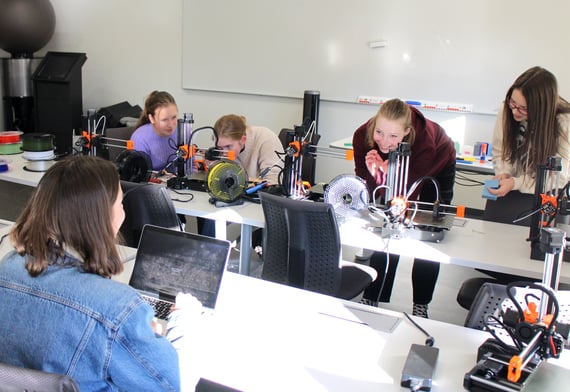Cegal helps girls succeed in a global coding competition
With an all-girls team, eight girls hope to program their way to a place in the Nordic and European finals of the FIRST LEGO League competition. SYSCO helps the girls on their journey. Far ahead, the global final in the United States entices.
“Last year we were on a mixed team, with seven boys and three girls. Then the girls were set to write reports while the boys programmed. But we also wanted to program. So, we took the initiative to put together an all-girls team this year. Then we get to do everything – including coding”, says Alexandra Jakobsen (14) and Mille Korsgaard (15).
Both are in the 10th grade at Norges Realfagsgymnas Ungdomsskole (NRGU). Together with fellow students Lovise Foss Linnestad (15), Nora Andreaa Wergeland (14), Sara-Emilia Cieśla Shahdadfar (15), Victoria Dale-Melleby (15), Ingeborg Hamnes Myrdal (14) og Hermine Skjelbred-Eriksen (15) they participate in the FIRST LEGO League (FLL) competition. They called the group Strawberry Pi, a twist from “Raspberry Pi”, the gold standard for anyone who loves programming.
The goal is to make it to the finals in United States with teams from across the world, but first they have to defeat local teams in Eastern Norway. Then the best teams from Norway will compete, and then there is finals in the Nordics, in Europe and finally in the United States. The competition is tough, with over 700,000 participants from over 110 countries. The road to the final is long and Cegal is among the companies that helps them along the way.
An all-girls team in programming is unusual, even in a LEGO context. However, Strawberry Pi is far ahead of the other teams from NRGU that participates in FLL. And there is no indication that the girls are lost behind a 3D-printer – literally speaking. When Cegal visited, a couple of them were in the process of fixing a 3D-printer, while others were writing code and documenting.
Sara-Emilia Cieśla Shadadfar, Alexandra Jakobsen, Lovise Foss Linnestad, Nora Andrea Wergeland og Mille Korsgaard
Coding competition for children and youth
FIRST LEGO League is an annual team competition for anyone who wants to sign up, either as a part of a teaching program in school or kindergarten, or as a group of friends. With the competition, LEGO aims to inspire children and young people aged 4-16 to become tomorrow’s engineers, researchers, and problem solvers. Through current issues assignments, the participants are introduced to science, technology, engineering, and math (STEM) through fun and engaging learning.
The competition is divided into two parts, where one part is about programming a robot to perform various tasks in a standardized, limited area. LEGO building is of course part of this, and the programming is done using the LEGO robot series Mindstorms.
“This is the most important part of the competition. Last year, our team won the technology award for the best program in the local final”, says Alexandra Jakobsen, before she presses the start button and lets the Strawberry Pi robot roll off and show its tricks. These include opening and closing doors, moving boxes and creating various chain reactions on the board that represent a logistics hub.
Mille Korsgaard and Alexandra Jakobsen explains how FloatCon 3.14 will work on a container.
Sustainable container transport
In the other part of the FFL competition, the participants will present a project that makes the transport sector more sustainable.
“We have created a solution to the problem of containers falling in the sea during transport”
Mille Korsgaard
In 2020, 3,112 containers fell overboard. There are many reasons why thousands of containers float and sink in the world’s oceans. Increasingly rougher weather, more transport and higher container stacks on the ships, combined with smaller crews on board, are some of them.
3,000 containers can seem like a drop in the ocean when there were 226 million containers that crossed the world’s oceans in 2020. However, the missing containers lead to both major economic losses, accidents, and pollution in our vulnerable oceans.
“We found that these containers also destroy coral reefs that store 18 times more CO2 than rainforest areas. This CO2 disappears into the atmosphere when the coral reefs are destroyed”, says Hermine Skjelbred-Eriksen.
“Our proposal is to equip the containers with an inflatable ‘floating vest’ that is attached to a cavity under the container. Since all containers are the same, they can all be equipped with the same solution. It has been named FloatCon 3.14 – i.e. Pi”, says Lovise Foss Linnestad.
Cegal an obvious supporting partner
Victoria Dale-Melleby adds that it was natural to have Cegal as a supporting partner.
“We have learned that Cegal is working to get more girls into the technology industry, especially as programmers, developers and technologists.”
Victoria Dale-Melleby, Strawberry Pi
“Strawberry Pi meets many of our core values. They work for a more sustainable world and use technology with the goal of solving environmental challenges. And we have a number of initiatives to get more women to work with the ‘heavy’ parts of the technology industry. That’s why we cheer on Strawberry Pi”
Marketing Director Camilla Bakjord in Cegal.

